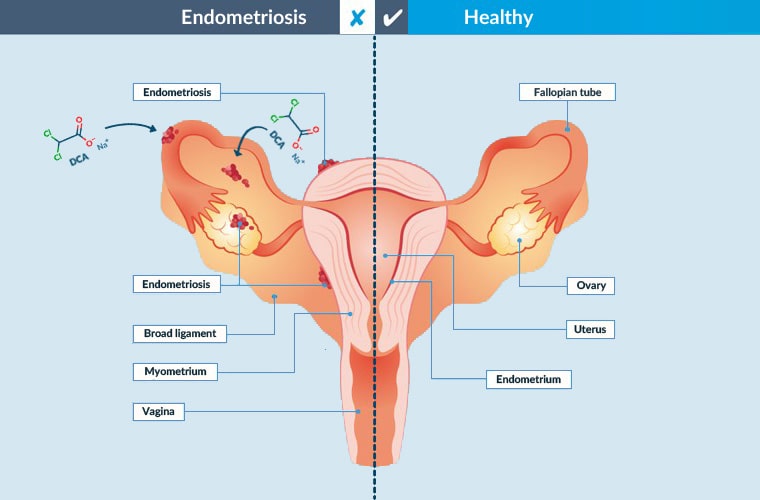Numbers show endometriosis affects about 190 million (10%) women and girls of reproductive age across the globe. Approximately one in 10 women in the world will develop endometriosis at one point in their lives. In the US, at least 11% of women (over 6.5 million) have endometriosis. (Ref.1),(Ref.2),(Ref.3)
The biggest problem with endometriosis, besides the symptoms it causes, is that adequate treatment is nonexistent. However, the first preclinical studies reveal groundbreaking results suggesting that Sodium dichloroacetate (DCA) could aid in managing this painful condition.

Proper treatment for endometriosis doesn’t exist just yet. In most cases, doctors manage symptoms in endometriosis patients through contraceptive drugs. However, they have plenty of uncomfortable adverse reactions, including changes in mood, weight gain, increased risk of thrombosis and depression. Furthermore, they have a counter-productive effect for women that are trying to conceive in their childbearing age. (Ref.)
For that reason, findings made by the researchers at the University of Edinburgh hold major significance as they show the possibility of a more adequate treatment method for this condition.
It is worth mentioning endometriosis exhibits cancer-like biochemical features. Tumor cells rely on aerobic glycolysis, which increases lactate secretion. Interestingly, secretion of lactate and certain cytokines are also elevated in the peritoneal fluid of patients with endometriosis. (Ref.)
Sodium Dichloroacetate Potential in Managing Endometriosis
The study, published in the Proceedings of the National Academy of Sciences, demonstrated that it is possible to reverse these pathological alterations of human peritoneal mesothelial cells (HPMCs) with DCA.
The research has shown endometriosis HMPCs are more dependent on energy produced through glycolysis than the same cells in healthy women. Administration of DCA has the potential to correct their abnormal cellular energy state. In fact, this small-molecule medication successfully inhibited the release of HMPCs lactate in vitro, and oral administration decreased the size of endometriosis lesions in mice in vivo. (Ref.)
For the purpose of the study, scientists randomly assigned mice to receive either water or DCA for seven days. Mice in the DCA group received 100 mg/kg. To translate these important results to women, scientists are using the drug in an exploratory clinical trial. (Ref.)

Why does DCA for work for endometriosis? The groundbreaking research of scientists from the University of Edinburgh showed a cancer drug could help treat endometriosis, and several mechanisms could be involved in the process. (Ref.)
Mechanisms of DCA in Endometriosis Treatment
Scientists explain DCA acts as a PDK inhibitor, an enzyme that is overexpressed in some forms of cancer. The type of PDK, called PDK1, has the highest sensitivity to the inhibitory effects of DCA medication. When DCA inhibits PDK, a chain of reactions occurs that results with a lower presence of harmful metabolites like lactate. The medication can also inhibit pro-proliferative and pro-angiogenic transcription factors.
However, the drug could have an impact on other types of cells that are altered in women with endometriosis. For example, the lesions and macrophages in patients with endometriosis consist of a wide array of phenotypes.
DCA Impact on Other Altered Cells
The DCA treatment could encourage metabolic reprogramming of macrophages and navigate it to a pro-repair phenotype with a positive impact on endometriosis pathogenesis. (Ref.)
In other words, the pelvic wall of women with endometriosis produces higher levels of lactate, a potentially harmful waste product. This particularly harmful alteration is also observed in cancerous cells. After treatment with Sodium dichloroacetate, cells in endometriosis patients return to their normal and usual metabolic behavior. The amount of the above mentioned waste product reduces. Only a week after treatment with DCA, the endometriosis lesions became much smaller in mouse models.

While more research on this subject is necessary, treatment with DCA could be life-changing for women with endometriosis. DCA can become the first effective nonhormonal treatment for patients with this painful condition.
As mentioned above, current therapeutic strategies for women with endometriosis consist of contraceptive drugs, i.e., they are hormone-based. These kinds of treatments aren’t suitable for all women, particularly those who wish to conceive.
At the same time, these medications may also cause serious side effects. While surgery to remove lesions is also an option, the disease usually comes back within five years. The research at the University of Edinburgh demonstrated that the DCA medication might help treat endometriosis and reduce the size of lesions associated with it. Clinical trials are ongoing and will yield more information about this potentially revolutionary non-hormonal treatment for endometriosis.
It seems that Sodium dichloroacetate, a drug researched for cancer treatment, could give millions of women an opportunity to treat endometriosis without using medications that act on their hormones. The drug can also reduce waste product production that is otherwise increased in an endometriosis state and could be related to the symptoms of the dreaded disease.